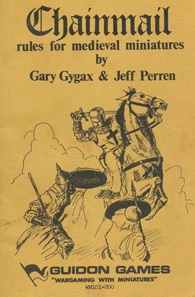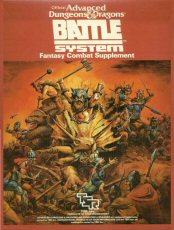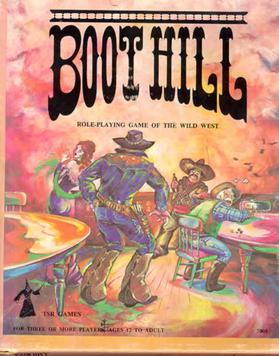Related Research Articles

A role-playing game is a game in which players assume the roles of characters in a fictional setting. Players take responsibility for acting out these roles within a narrative, either through literal acting or through a process of structured decision-making regarding character development. Actions taken within many games succeed or fail according to a formal system of rules and guidelines.

A wargame is a strategy game in which two or more players command opposing armed forces in a simulation of an armed conflict. Wargaming may be played for recreation, to train military officers in the art of strategic thinking, or to study the nature of potential conflicts. Many wargames re-create specific historic battles, and can cover either whole wars, or any campaigns, battles, or lower-level engagements within them. Many simulate land combat, but there are wargames for naval, air combat, and cyber as well as many that combine various domains.

TSR, Inc. was an American game publishing company, best known as the original publisher of Dungeons & Dragons (D&D). Its earliest incarnation, Tactical Studies Rules, was founded in October 1973 by Gary Gygax and Don Kaye. Gygax had been unable to find a publisher for D&D, a new type of game he and Dave Arneson were co-developing, so he founded the new company with Kaye to self-publish their products. Needing financing to bring their new game to market, Gygax and Kaye brought in Brian Blume in December as an equal partner. Dungeons & Dragons is generally considered the first tabletop role-playing game (TTRPG), and established the genre. When Kaye died suddenly in 1975, the Tactical Studies Rules partnership restructured into TSR Hobbies, Inc. and accepted investment from Blume's father Melvin. With the popular D&D as its main product, TSR Hobbies became a major force in the games industry by the late 1970s. Melvin Blume eventually transferred his shares to his other son Kevin, making the two Blume brothers the largest shareholders in TSR Hobbies.

David Lance Arneson was an American game designer best known for co-developing the first published role-playing game (RPG), Dungeons & Dragons, with Gary Gygax, in the early 1970s. Arneson's early work was fundamental to the role-playing game (RPG) genre, pioneering devices now considered to be archetypical, such as cooperative play to develop a storyline instead of individual competitive play to "win" and adventuring in dungeon, town, and wilderness settings as presented by a neutral judge who doubles as the voice and consciousness of all characters aside from the player characters.

Miniature wargaming is a form of wargaming in which military units are represented by miniature physical models on a model battlefield. Miniature wargames are played using model soldiers, vehicles, and artillery on a model battlefield, with the primary appeal being recreational rather than functional. Miniature wargames are played on custom-made battlefields, often with modular terrain, and abstract scaling is used to adapt real-world ranges to the limitations of table space. The use of physical models to represent military units is in contrast to other tabletop wargames that use abstract pieces such as counters or blocks, or computer wargames which use virtual models. The primary benefit of using models is immersion, though in certain wargames the size and shape of the models can have practical consequences on how the match plays out. Models' dimensions and positioning are crucial for measuring distances during gameplay. Issues concerning scale and accuracy compromise realism too much for most serious military applications.

Tabletop games or tabletops are games that are normally played on a table or other flat surface, such as board games, card games, dice games, miniature wargames, tabletop role-playing games, or tile-based games.

In miniature wargaming, players enact simulated battles using scale models called miniature models, which can be anywhere from 2 to 54 mm in height, to represent warriors, vehicles, artillery, buildings, and terrain. These models are colloquially referred to as miniatures or minis.

Chainmail is a medieval miniature wargame created by Gary Gygax and Jeff Perren. Gygax developed the core medieval system of the game by expanding on rules authored by his fellow Lake Geneva Tactical Studies Association (LGTSA) member Jeff Perren, a hobby-shop owner with whom he had become friendly. Guidon Games released the first edition of Chainmail in 1971.
Collectible miniatures games (CMGs) are a form of miniatures game that is also similar to collectible card games (CCGs) — the primary difference being that while CCGs are card-based games, CMGs feature miniature figures.
A gaming convention is a gathering centered on role-playing games, collectible card games, miniatures wargames, board games, video games, or other types of games. These conventions are typically two or three business days long, and often held at either a university or in a convention center hotel.

Battlesystem is a tabletop miniature wargame designed as a supplement for use with the Dungeons & Dragons role-playing game. The original Battlesystem was printed as a boxed set in 1985 for use with the first edition AD&D rules. For the second edition of AD&D, a new version of Battesystem was printed as a softcover book in 1989.

The history of role-playing games began when disparate traditions of historical reenactment, improvisational theatre, and parlour games combined with the rulesets of fantasy wargames in the 1970s to give rise to tabletop role-playing games (TTRPGs). Multiple TTRPGs were produced between the 1970s and early 1990s. In the 1990s, TTRPGs faced a decline in popularity. Indie role-playing game design communities arose on the internet in the early 2000s and introduced new ideas. In the late 2010s and early 2020s, TTRPGs experienced renewed popularity due to videoconferencing, the rise of actual play, and online marketplaces.

Boot Hill is a western-themed role-playing game designed by Brian Blume, Gary Gygax, and Don Kaye, and first published in 1975. Boot Hill was TSR's third role-playing game, appearing not long after Dungeons & Dragons (D&D) and Empire of the Petal Throne, and taking its name from "Boot Hill", the popular Wild West term for "cemetery". Boot Hill was marketed to take advantage of America's love of the western genre. The game did feature some new game mechanics, such as the use of percentile dice, but its focus on gunfighting rather than role-playing, as well as the lethal nature of its combat system, limited its appeal. Boot Hill was issued in three editions over 15 years, but it never reached the same level of popularity as D&D and other fantasy-themed role-playing games.

Siege of Bodenburg is a wargame developed in 1967 by Henry Bodenstedt. It is one of the earliest sets of rules for conducting battles with medieval miniatures.

The original Dungeons & Dragons boxed set by Gary Gygax and Dave Arneson was published by Tactical Studies Rules in 1974. It included the original edition of the Dungeons & Dragons fantasy role-playing game. Its product designation was TSR 2002.

A tabletop role-playing game, also known as a pen-and-paper role-playing game, is a kind of role-playing game (RPG) in which the participants describe their characters' actions through speech and sometimes movements. Participants determine the actions of their characters based on their characterization, and the actions succeed or fail according to a set formal system of rules and guidelines, usually involving randomization. Within the rules, players have the freedom to improvise, and their choices shape the direction and outcome of the game.

A collectible card game (CCG), also called a trading card game (TCG) among other names, is a type of card game that mixes strategic deck building elements with features of trading cards. It was introduced with Magic: The Gathering in 1993.
A digital collectible card game (DCCG) or online collectible card game (OCCG) is a computer or video game that emulates collectible card games (CCG) and is typically played online or occasionally as a standalone video game. Many DCCGs are types of digital tabletop games and follow traditional card game-style rules, while some DCCGs use alternatives for cards and gameboards, such as icons, dice and avatars. Originally, DCCGs started out as replications of a CCG's physical counterpart, but many DCCGs have foregone a physical version and exclusively release as a video game, such as with Hearthstone.
A digital tabletop game is a video game genre characterized by gameplay similar to physical tabletop games such as board games, card games, and role-playing games. Many digital tabletop games are adaptions of existing physical games, although some digital tabletop games were created only as video games. Players can also use tabletop game simulators to recreate tabletop games using various game pieces.
References
- ↑ Hyde, Henry (2013). The Wargaming Compendium. United Kingdom: Pen and Sword Books. ISBN 9781783830695. OCLC 867929190 – via EBSCOhost eBook Collection.
- 1 2 3 Tresca, Michael J. (2011). "2. Collectible Card Games and Miniature Wargames". The Evolution of Fantasy Role-Playing Games. McFarland & Company. ISBN 978-0-7864-5895-0. LCCN 2010039606 . Retrieved 24 March 2019– via Google Books.
- ↑ Newman, Kyle; Witwer, Michael; Peterson, Jon; Witwer, Sam (October 2018). Dungeons and Dragons Art and Arcana: A Visual History. Potter/TenSpeed/Harmony/Rodale. ISBN 9780399580949.
- ↑ Cogburn, Jon; Silcox, Mark (2012). Dungeons and Dragons and Philosophy: Raiding the Temple of Wisdom. Open Court Publishing. p. 237. ISBN 9780812697964.
